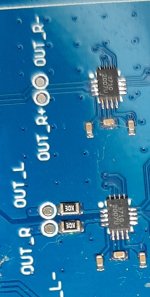Considering the millions of different smd components on the market it would help a bit more information like:
Make and model of the device that board came from or belongs to.
Schematic for that board.
Just a picture of the component doesn't help much.
Make and model of the device that board came from or belongs to.
Schematic for that board.
Just a picture of the component doesn't help much.
I suspect those are short-form manufacturer codes on the packages, there's not enough room on small SMT devices for a real part number - you need to know the manufacturer first and try to find their device marking codes...
It appears to be handling a differential analog signal, so may be a fully differential attenuator/digipot or similar.
It appears to be handling a differential analog signal, so may be a fully differential attenuator/digipot or similar.
Topping E50, is a DAC. That components are after the output stage. They just close and open like a relay but is an electronic one.Considering the millions of different smd components on the market it would help a bit more information like:
Make and model of the device that board came from or belongs to.
Schematic for that board.
Just a picture of the component doesn't help much.
No service manual available but there is a software upgrade have you tried that ?Topping E50, is a DAC. That components are after the output stage. They just close and open like a relay but is an electronic one.
Output relays or muting relays very rarely go bad the last device (different brand) I fixed it was the driver(s) for the relay that was at fault
Fairchild/ onsemi has some output switches of various kinds, maybe you could start looking there? That would be my first go-to place.
I have found nothing in the smd code search.
3710... is the switch USB compatible? What else does the output multiplex with, or why is the switch even there?
year of manufacture? it's possible it's no longer made...
Good luck trying to find anything
https://www.onsemi.com/products/interfaces/analog-switches
I have found nothing in the smd code search.
3710... is the switch USB compatible? What else does the output multiplex with, or why is the switch even there?
year of manufacture? it's possible it's no longer made...
Good luck trying to find anything
https://www.onsemi.com/products/interfaces/analog-switches
Exactly, just a muting circuit. The unit is made in summer of 2021.From what I can see is just a output muting circuit
https://www.audiosciencereview.com/forum/index.php?threads/topping-e50-review-balanced-dac.26219/
The million £££ question:
Did you check for the drive signal or did you just assumed the relays are faulty ?
By the way Happy New Years everybody
Did you check for the drive signal or did you just assumed the relays are faulty ?
By the way Happy New Years everybody
I will try this.The million £££ question:
Did you check for the drive signal or did you just assumed the relays are faulty ?
By the way Happy New Years everybody
And what does the Texas Instruments website say about analog switchers/mute, etc? Or, at last Analog Devices?I will try this.
There are SMD parts, electronic relays, for audio signal. What kind of relays are these ?
OK, hear me out!
https://www.nexperia.com/packages/SOT1161-1.html
First I had to find the package, you should have done that first, it's XQFN-16
Nexperia -- phillips uses these, and the markings you have, I think I saw in a $40 tablet once or twice... don't remember now
so far no luck...
Can you see the 0805 resistors in the picture?plastic, "leadless extremely thin quad flat package"
Really ?
Look at the picture in post one
I have access to this picture, not sure which one are you seeing:
https://www.diyaudio.com/community/attachments/20211227_122531-jpg.1009197/
Yes that's the pic and yes I can see the 2 resistors what I meant was the IC package/format the XQFN-16 is a leadless and looking close on the picture I can swear I can see the leads.
An unusual leaded package, 16 pin with 4 on each side, but not square. Flipping the board over to look for thermal vias, would tell you if there is also a power pad underneathYes that's the pic and yes I can see the 2 resistors what I meant was the IC package/format the XQFN-16 is a leadless and looking close on the picture I can swear I can see the leads.
The XQFN-16 and HXQFN-16 package are very similar but both don't have leads.
Found some "analog switches" in that format yesterday looking for other stuff (Mouser).
PS: The joys of "Made in China" devices...
Found some "analog switches" in that format yesterday looking for other stuff (Mouser).
PS: The joys of "Made in China" devices...
...that's the solder...Yes that's the pic and yes I can see the 2 resistors what I meant was the IC package/format the XQFN-16 is a leadless and looking close on the picture I can swear I can see the leads.
You couldn't solder that device like that if it was an XQFN-16 or HXQFN-16 package even if you tried.
Good luck to greierasul in his repair but I'm out.
Good luck to greierasul in his repair but I'm out.
soldering is the easy part, as is the desoldering, no one is really bonding components with glue like in the 1206 era...You couldn't solder that device like that if it was an XQFN-16 or HXQFN-16 package even if you tried.
Good luck to greierasul in his repair but I'm out.
and the component will be NXP/Nexperia as suggested, XQFN16 is almost only made by them.
The component could be something like NX3DV2007GU but I see no such thing, so maybe another name? It's not my job to go over all the datasheets...
- Home
- Design & Build
- Parts
- What type of solid state relays are these ?
